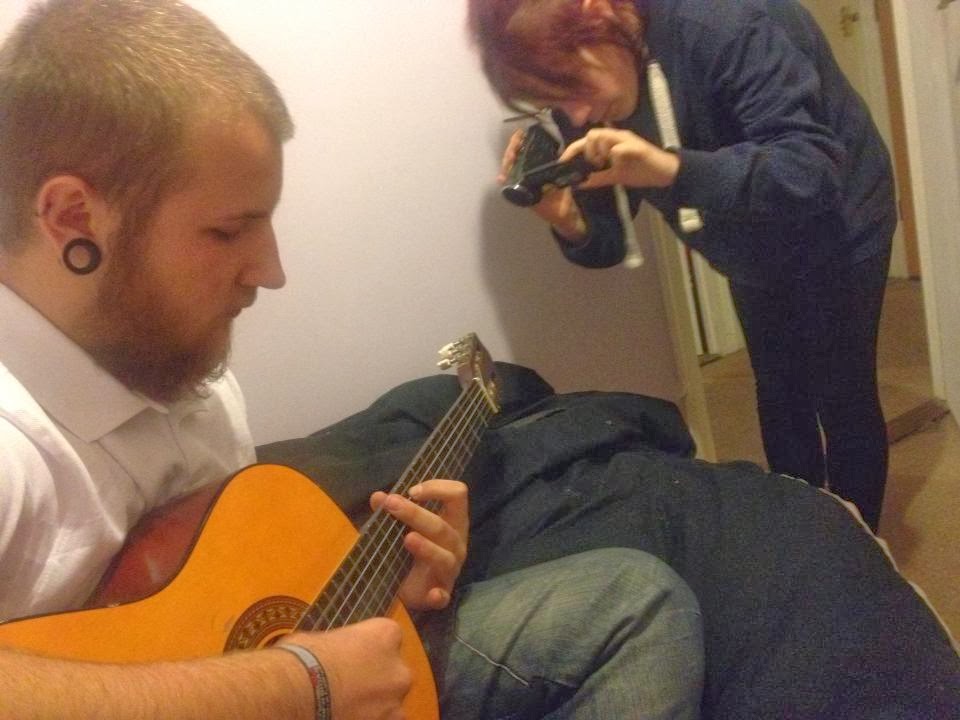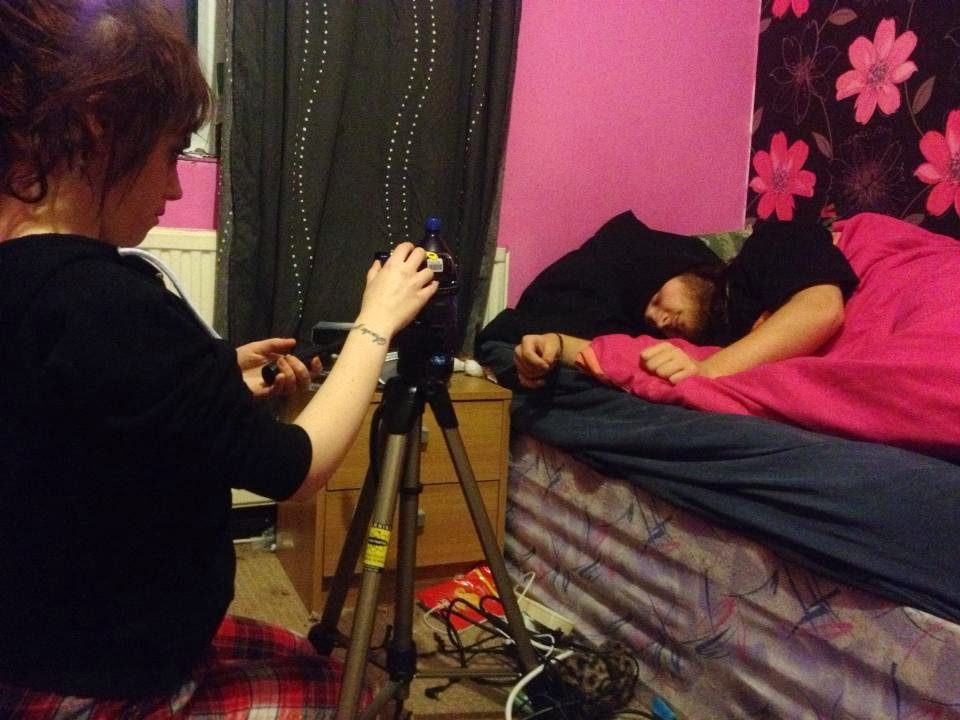After I finished my first full draft of my music video, I decided that there were some corrections to be made in both editing and filming. These are the notes I made whilst watching my music video regarding the full scene that I had planned on re-filming..
I decided to re-film this scene because although I wanted my video to be a cautionary tale of a descent into drugs, I thought that depicting my artist using a Class A drug like heroin was too much and would possibly put the audience off.
Thursday, 30 January 2014
Music Video Shooting - Day Six
shooting diary
The plan for day six was to complete the shots that were missed on day four (i.e. the car scene). Like day four, we all had to be up and ready at an early time to ensure that our filming went undisturbed. I decided on a last minute wardrobe change for Liam (from a denim jacket to a black hoodie) which meant that the shots I had managed to take on day four were no longer of use due to continuity purposes. We managed to film the whole car scene without any interruptions. This included the several different shots which were going to culminate together to give the audience the impression that my character had been run over.
The plan for day six was to complete the shots that were missed on day four (i.e. the car scene). Like day four, we all had to be up and ready at an early time to ensure that our filming went undisturbed. I decided on a last minute wardrobe change for Liam (from a denim jacket to a black hoodie) which meant that the shots I had managed to take on day four were no longer of use due to continuity purposes. We managed to film the whole car scene without any interruptions. This included the several different shots which were going to culminate together to give the audience the impression that my character had been run over.
Music Video Planning & Preparation (Audience Research) - Blog Poll Results
I compiled my results into pie charts. I don't believe there is anything that needs changing in the structure of the question or answers as it is basic and straight forward.
Question One
Question Two
Question Three
Question Four
Question Five
Wednesday, 29 January 2014
Music Video First Drafts
These are the first drafts of my music video, there are some shots missing due to weather and camera complications.
This is my original first draft before I added a filter. This is my first draft after I added the the filtert to certain scenes in o9rder to show the viewer that it was meant to be in the past.
This is my original first draft before I added a filter. This is my first draft after I added the the filtert to certain scenes in o9rder to show the viewer that it was meant to be in the past.
Friday, 24 January 2014
Music Video Shooting - Day Five
shooting diary
 After the first four initial days filming I got a chance to edit what footage I had. This gave me a chance to get used to the software (Adobe Premiere, which I had never used before), experiment with some of the visual effects that were available and I was able to put together all of my footage so far. This allowed me to find any parts that needed re-filming and helped me to decide what needed changing completely, along with the visual effects I now wanted to add. I started off by filming some more shots of the performance, these were mostly close-ups of Liam's hand playing chords and extreme close-ups panning side-to-side of the guitar.
After the first four initial days filming I got a chance to edit what footage I had. This gave me a chance to get used to the software (Adobe Premiere, which I had never used before), experiment with some of the visual effects that were available and I was able to put together all of my footage so far. This allowed me to find any parts that needed re-filming and helped me to decide what needed changing completely, along with the visual effects I now wanted to add. I started off by filming some more shots of the performance, these were mostly close-ups of Liam's hand playing chords and extreme close-ups panning side-to-side of the guitar.
 I then went on to film the bedroom argument scene with me and Liam. I originally wanted there to be a point of view shot from Liam's perspective which involved a focus shift. Unfortunately the camera I used would not allow me to do the focus shift to the quality and standard that I had hoped for. Instead, I opted for a slow pan. The shots with me and Liam arguing were difficult to light and don't look as good as they should which is a factor in my consideration of re-filming this scene.
I then went on to film the bedroom argument scene with me and Liam. I originally wanted there to be a point of view shot from Liam's perspective which involved a focus shift. Unfortunately the camera I used would not allow me to do the focus shift to the quality and standard that I had hoped for. Instead, I opted for a slow pan. The shots with me and Liam arguing were difficult to light and don't look as good as they should which is a factor in my consideration of re-filming this scene.
I concluded by filming the last shots of Liam's narrative scene, these were the final shots of him getting dressed. I decided to add a few extra shots due to my new knowledge of video editing. I wanted my character to appear in the mirror as a figment of his imagination but I also wanted to fade away to avoid confusion with the audience due to my character being deceased at this point. I filmed this by filming one shot of Liam on his own looking in the mirror, stopping the recording then jumping into shot and recording for a further period of time. I then overlapped the two shots and slowly turned down the opacity on the shot I was in, causing it to give the effect of me slowly disappearing.
 After the first four initial days filming I got a chance to edit what footage I had. This gave me a chance to get used to the software (Adobe Premiere, which I had never used before), experiment with some of the visual effects that were available and I was able to put together all of my footage so far. This allowed me to find any parts that needed re-filming and helped me to decide what needed changing completely, along with the visual effects I now wanted to add. I started off by filming some more shots of the performance, these were mostly close-ups of Liam's hand playing chords and extreme close-ups panning side-to-side of the guitar.
After the first four initial days filming I got a chance to edit what footage I had. This gave me a chance to get used to the software (Adobe Premiere, which I had never used before), experiment with some of the visual effects that were available and I was able to put together all of my footage so far. This allowed me to find any parts that needed re-filming and helped me to decide what needed changing completely, along with the visual effects I now wanted to add. I started off by filming some more shots of the performance, these were mostly close-ups of Liam's hand playing chords and extreme close-ups panning side-to-side of the guitar. I then went on to film the bedroom argument scene with me and Liam. I originally wanted there to be a point of view shot from Liam's perspective which involved a focus shift. Unfortunately the camera I used would not allow me to do the focus shift to the quality and standard that I had hoped for. Instead, I opted for a slow pan. The shots with me and Liam arguing were difficult to light and don't look as good as they should which is a factor in my consideration of re-filming this scene.
I then went on to film the bedroom argument scene with me and Liam. I originally wanted there to be a point of view shot from Liam's perspective which involved a focus shift. Unfortunately the camera I used would not allow me to do the focus shift to the quality and standard that I had hoped for. Instead, I opted for a slow pan. The shots with me and Liam arguing were difficult to light and don't look as good as they should which is a factor in my consideration of re-filming this scene.I concluded by filming the last shots of Liam's narrative scene, these were the final shots of him getting dressed. I decided to add a few extra shots due to my new knowledge of video editing. I wanted my character to appear in the mirror as a figment of his imagination but I also wanted to fade away to avoid confusion with the audience due to my character being deceased at this point. I filmed this by filming one shot of Liam on his own looking in the mirror, stopping the recording then jumping into shot and recording for a further period of time. I then overlapped the two shots and slowly turned down the opacity on the shot I was in, causing it to give the effect of me slowly disappearing.
Wednesday, 22 January 2014
Media Theory - Two-Step Flow Model (Lazarsfeld)
This model has been developed from the 'Hypodermic Needle' theory and sees the audience as active participants. It works by the mass media passing on a message to an 'opinion leader' who will then share that with their peers. An example of this would be watching a television show on the recommendation of a friend. The increase in the use of social media has opened up a whole new way of peer to peer sharing. Examples of this would be people sharing a link to a YouTube video on their Twitter profile which is then watched by their friends or someone sharing a status update on Facebook about what they are watching which also contains a hyperlink to the media text on websites such as Netflix.
Media Theory - Narrative Theory (Todorov)
Todorov believed that all media texts told a story, he believed that there was a specific process containing several stages that could decide a specific narrative structure. This theory can be applied to my own work regardless of its non-linear narrative structure.
The Stages of Narrative Theory:
Stage 1 - Equilibrium
The normality depicted at the beginning of the narrative. Everything is balanced, happy and normal. This gives the viewer an idea of the average, everyday life that the protagonist leads.
Stage 2 - Disruption
The previously shown normality of the equilibrium is disrupted. This is usually caused by a conflict between two characters, the actions of a character or an unexpected event.
Stage 3 - Recognition
The disruption is acknowledged by the antagonist, causing it to affect their lives.
Stage 4 - Repair
The protagonist in the narrative attempts to repair the disruption, usually a difficult challenge for the protagonist.
Stage 5 - New Equilibrium
A sense of normality has returned to the narrative. It is named 'new' equilibrium because, although normality is restored, due to the disruption things are now different from the original equilibrium.
The Stages of Narrative Theory applied to my own work:
Stage 1 - Equilibrium
Stage 2 - Disruption
Stage 3 - Recognition
Stage 4 - Repair
Stage 5 - New Equilibrium
Tuesday, 21 January 2014
Subscribe to:
Comments (Atom)












